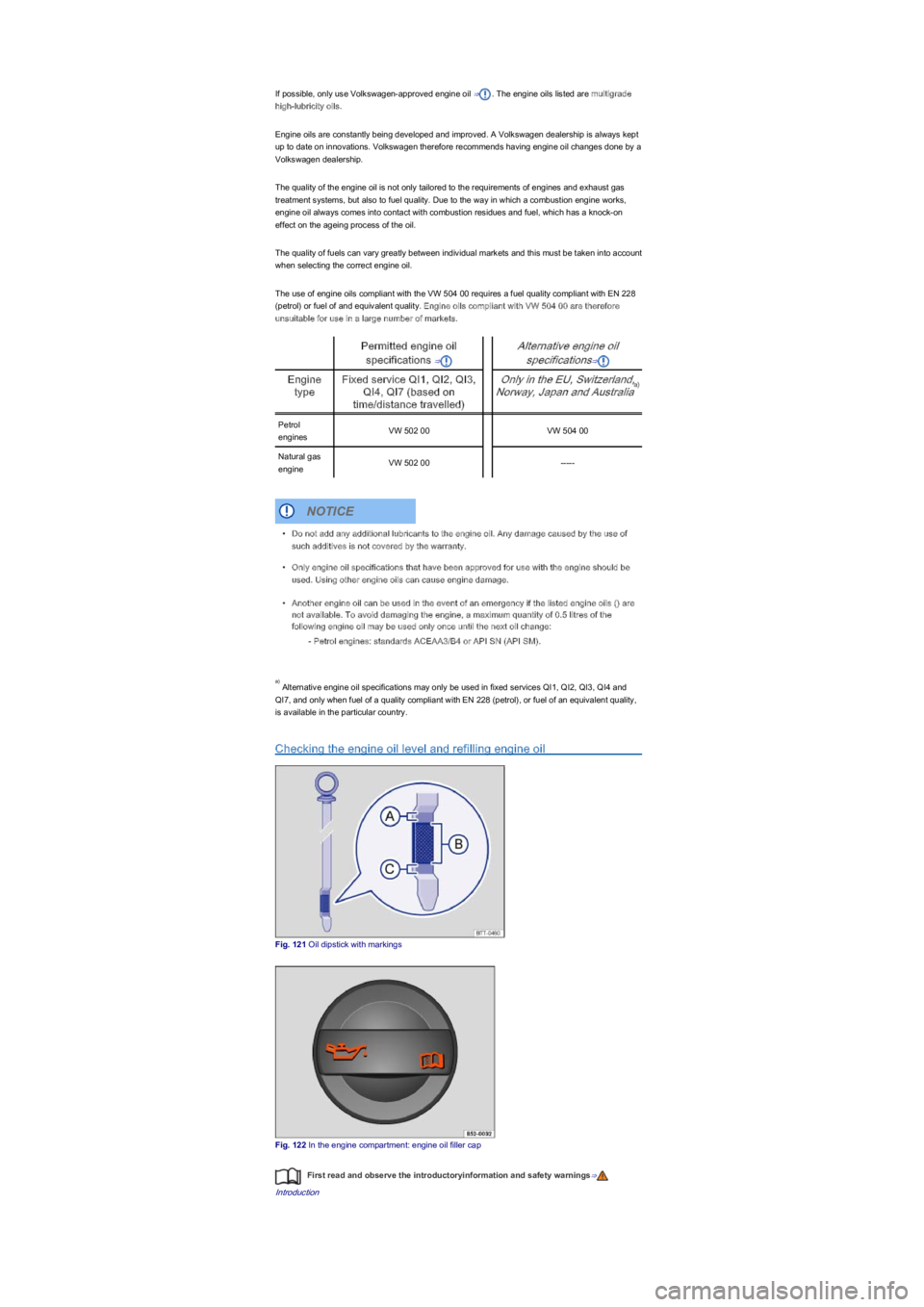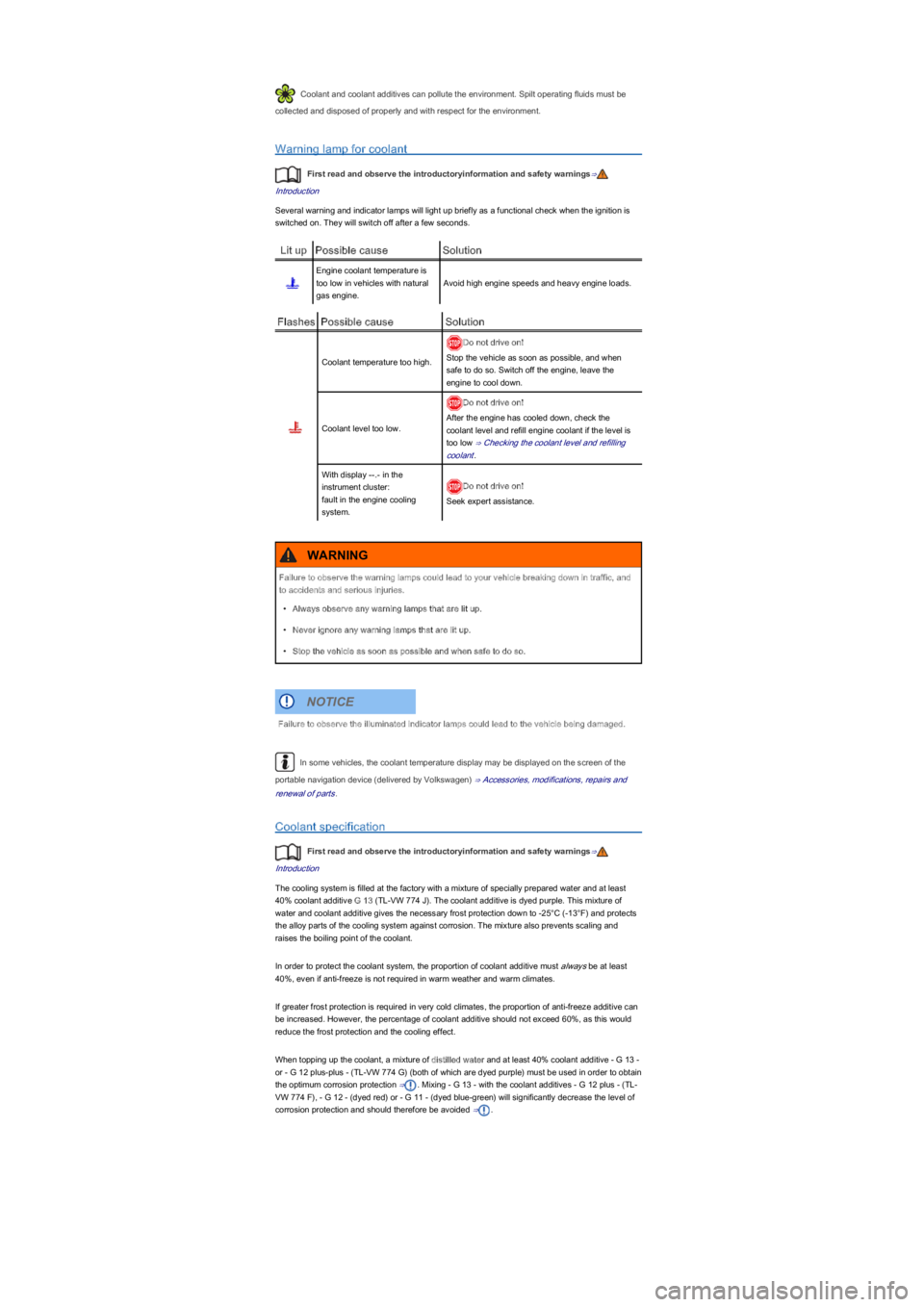Page 135 of 211
Engine oil
Introduction
This chapter contains information on the followingsubjects:
⇒ Warning and indicator lamps
⇒ Engine oil specification
⇒ Checking the engine oil level and refilling engine oil
⇒ Engine oil consumption
⇒ Changing engine oil
Additional information and warnings:
\f
Page 136 of 211

If possible, only use Volkswagen-approved engine oil ⇒. The engine oils listed are multigrade
high-lubricity oils.
Engine oils are constantly being developed and improved. A Volkswagen dealership is always kept
up to date on innovations. Volkswagen therefore recommends having engine oil changes done by a
Volkswagen dealership.
The quality of the engine oil is not only tailored to the requirements of engines and exhaust gas
treatment systems, but also to fuel quality. Due to the way in which a combustion engine works,
engine oil always comes into contact with combustion residues and fuel, which has a knock-on
effect on the ageing process of the oil.
The quality of fuels can vary greatly between individual markets and this must be taken into account
when selecting the correct engine oil.
The use of engine oils compliant with the VW 504 00 requires a fuel quality compliant with EN 228
(petrolyf���R�U���I�X�H�O���R�I���D�Q�G���H�T�X�L�Y�D�O�H�Q�W���T�X�D�O�L�W�\��� Engine oils compliant with VW 504 00 are therefore
unsuitable for use in a large number of markets.
Permitted engine oil
specifications ⇒
Alternative engine oil
specifications⇒
Engine
type
Fixed service QI1, QI2, QI3,
QI4, QI7 (based on
time/distance travelledyf
Only in the EU, Switzerland,
Norway, Japan and Australia
Petrol
enginesVW 502 00VW 504 00
Natural gas
engineVW 502 00-----
Alternative engine oil specifications may only be used in fixed services QI1, QI2, QI3, QI4 and
QI7, and only when fuel of a quality compliant with EN 228 (petrolyf�����R�U���I�X�H�O���R�I���D�Q���H�T�X�L�Y�D�O�H�Q�W���T�X�D�O�L�W�\���
is available in the particular country.
Checking the engine oil level and refilling engine oil
Fig. 121 Oil dipstick with markings
Fig. 122 In the engine compartment: engine oil filler cap
First read and observe the introductoryinformation and safety warnings⇒
Introduction
ayf
\f
Page 138 of 211

Changing engine oil
First read and observe the introductoryinformation and safety warnings⇒
Introduction
The engine oil must be changed regularly in accordance with the data given in the service
schedule.
The engine oil and filter should always be changed, and used oil disposed of, by a qualified
workshop due to the special tools and knowledge required. Volkswagen recommends using a
Volkswagen dealership for this purpose.
More details on the service intervals can be found in the service schedule.
Additives in the engine oil can cause new engine oil to discolour quickly. This is normal and does
not mean that the engine oil should be changed more frequently.
Before changing the engine oil, first find out where old oil can be disposed of properly near
you.
Used oil must be disposed of in accordance with regulations governing the protection of the
environment. Never dispose of old oil in locations such as gardens, woods, sewerage systems, on
streets and roads, or in rivers and waterways.
Coolant
Introduction
This chapter contains information on the followingsubjects:
⇒ Warning lamp for coolant
⇒ Coolant specification
⇒ Checking the coolant level and refilling coolant
Never carry out any work on the engine coolant system if you are not familiar with the requisite
procedures, or if you do not have access to the correct tools, operating equipment and fluids ⇒.
The work should be carried out by a qualified workshop if you are uncertain. Volkswagen
recommends using a Volkswagen dealership for this purpose.
Serious injuries can be caused if work is carried out incorrectly.
Additional information and warnings:
\f
Page 139 of 211

Coolant and coolant additives can pollute the environment. Spilt operating fluids must be
collected and disposed of properly and with respect for the environment.
Warning lamp for coolant
First read and observe the introductoryinformation and safety warnings⇒
Introduction
Several warning and indicator lamps will light up briefly as a functional check when the ignition is
switched on. They will switch off after a few seconds.
Lit upPossible causeSolution
Engine coolant temperature is
too low in vehicles with natural
gas engine.
Avoid high engine speeds and heavy engine loads.
FlashesPossible causeSolution
Coolant temperature too high.
Do not drive on!
Stop the vehicle as soon as possible, and when
safe to do so. Switch off the engine, leave the
engine to cool down.
Coolant level too low.
Do not drive on!
After the engine has cooled down, check the
coolant level and refill engine coolant if the level is
too low ⇒ Checking the coolant level and refilling
coolant.
With display --.- in the
instrument cluster:
fault in the engine cooling
system.
Do not drive on!
Seek expert assistance.
In some vehicles, the coolant temperature display may be displayed on the screen of the
portable navigation device (delivered by Volkswagenyf� ⇒ Accessories, modifications, repairs and
renewal of parts.
Coolant specification
First read and observe the introductoryinformation and safety warnings⇒
Introduction
The cooling system is filled at the factory with a mixture of specially prepared water and at least
40yb���F�R�R�O�D�Q�W���D�G�G�L�W�L�Y�H� G 13 (TL-VW 774 Jyf�����7�K�H���F�R�R�O�D�Q�W���D�G�G�L�W�L�Y�H���L�V���G�\�H�G���S�X�U�S�O�H�����7�K�L�V���P�L�[�W�X�U�H���R�I�
water and coolant additive gives the necessary frost protection down to -25°C (-13°Fyf���D�Q�G���S�U�R�W�H�F�W�V�
the alloy parts of the cooling system against corrosion. The mixture also prevents scaling and
raises the boiling point of the coolant.
In order to protect the coolant system, the proportion of coolant additive must always be at least
40yb�����H�Y�H�Q���L�I���D�Q�W�L���I�U�H�H�]�H���L�V���Q�R�W���U�H�T�X�L�U�H�G���L�Q���Z�D�U�P���Z�H�D�W�K�H�U���D�Q�G���Z�D�U�P���F�O�L�P�D�W�H�V�.
If greater frost protection is required in very cold climates, the proportion of anti-freeze additive can
be increased. However, the percentage of coolant additive should not exceed 60yb�����D�V���W�K�L�V���Z�R�X�O�G�
reduce the frost protection and the cooling effect.
When topping up the coolant, a mixture of distilled water and at least 40yb���F�R�R�O�D�Q�W���D�G�G�L�W�L�Y�H� - G 13 -
or - G 12 plus-plus - (TL-VW 774 Gyf�����E�R�W�K���R�I���Z�K�L�F�K���D�U�H���G�\�H�G���S�X�U�S�O�H�\f must be used in order to obtain
the optimum corrosion protection ⇒. Mixing - G 13 - with the coolant additives - G 12 plus - (TL-
VW 774 Fyf��� - G 12 - (dyed redyf���R�U� - G 11 - (dyed blue-greenyf���Z�L�O�O���V�L�J�Q�L�I�L�F�D�Q�W�O�\���G�H�F�U�H�D�V�H���W�K�H���O�H�Y�H�O���R�I�
corrosion protection and should therefore be avoided ⇒.
Failure to observe the warning lamps could lead to your vehicle breaking down in traffic, and
to accidents and serious injuries.
\f